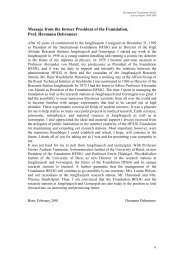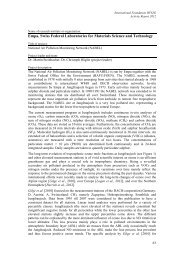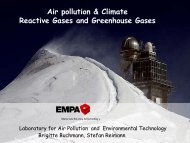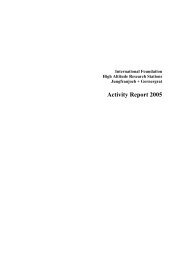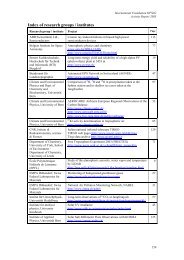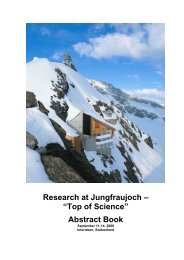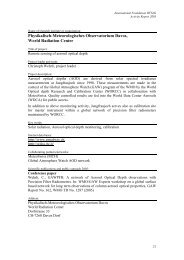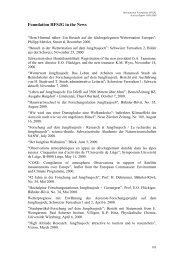National Air Pollution Monitoring Network (NABEL) - Empa
National Air Pollution Monitoring Network (NABEL) - Empa
National Air Pollution Monitoring Network (NABEL) - Empa
You also want an ePaper? Increase the reach of your titles
YUMPU automatically turns print PDFs into web optimized ePapers that Google loves.
International Foundation HFSJG<br />
Activity Report 2004<br />
Name of research institute or organization:<br />
EMPA Materials Science and Technology<br />
Title of project:<br />
<strong>National</strong> <strong>Air</strong> <strong>Pollution</strong> <strong>Monitoring</strong> <strong>Network</strong> (<strong>NABEL</strong>)<br />
Project leader and team<br />
Christoph Hüglin, Beat Schwarzenbach, Martin Steinbacher,<br />
Ernest Weingartner (Paul Scherrer Institute, PSI)<br />
Project description:<br />
The national air pollution monitoring network <strong>NABEL</strong> is a joint project of the Swiss<br />
Agency for Environment, Forests and Landscape (BUWAL) and EMPA. The<br />
<strong>NABEL</strong> network consists of 16 monitoring stations that are distributed all over<br />
Switzerland. The monitoring stations represent the most important air pollution<br />
levels. The <strong>NABEL</strong> site at Jungfraujoch is a very low polluted site, representing a<br />
background station for the lower free troposphere in central Europe.<br />
The measurement programme at Jungfraujoch includes the continuous measurement<br />
of the following gaseous pollutants: Ozone (O 3 ), carbon monoxide (CO), nitrogen<br />
monoxide (NO), nitrogen dioxide (NO 2 ), and the sum of nitrogen oxides (NO y ). In<br />
addition, a selection of VOCs (alkanes, aromatics) are measured with a time<br />
resolution of four hours. Daily samples are taken for determination of gaseous SO 2<br />
and for particulate sulphur. Finally, 48-hour samples of total suspended particulate<br />
matter (TSP) are collected by use of a high volume sampler. TSP mass concentration<br />
is determined from the difference of the filter weight before and after particle<br />
collection (gravimetric method). The TSP filter samples are also used to determine<br />
the concentrations of lead and cadmium in suspended particulate matter.<br />
Since June 16, 2004, a beta attenuation monitor (Thermo ESM Andersen FH62 I-R)<br />
is used for continuous measurements of TSP. These measurements complement the<br />
gravimetric 48-hour TSP values, as well as continuous measurements of PM1 (mass<br />
concentration of particles with diameter less than 1µm) that are also performed with a<br />
a beta attenuation monitor by the Paul Scherrer Institute. The PM1 measurements<br />
belong to the aerosol characterization activities within the Global Atmosphere Watch<br />
Programme (GAW). The main reason for starting continuous TSP measurements at<br />
Jungfraujoch was to more accurately investigate the contribution of Saharan dust<br />
events (SDEs) to TSP at Jungfraujoch. This can be done by combining TSP data with<br />
continuous identification of Saharan dust events by measurement of the optical<br />
properties of the aerosol (Collaud Coen et al., 2004).<br />
Figure 1 shows the data for TSP (gravimetric method and continuous beta attenuation<br />
method) and PM1 as 48h mean values. Continuously measured TSP and<br />
gravimetrically determined TSP agree very well (r 2 =0.91, see Figure 2, left), although<br />
some of the the continuously measured values are systematically higher than the<br />
gravimetrically determined values. The correlation between PM1 and TSP is poor<br />
(r 2 =0.34, see Figure 2, right), i.e. there are events where TSP concentrations are<br />
markedly elevated, but PM1 remains more or less unchanged. Three of these events<br />
29
International Foundation HFSJG<br />
Activity Report 2004<br />
(Oct. 5-6, Oct. 8-10, and Dec. 7-9) were identified as Saharan dust events by visual<br />
inspection of TSP collected on the 48-hour filter samples. Figure 3 gives the hourly<br />
mean values of TSP and PM1 during the three identified Saharan dust events.<br />
Evaluation of these three events indicate that Saharan dust is almost entirely in the<br />
size fraction above PM1.<br />
48h particle mass concentration (ug/m3)<br />
0 5 10 15 20 25<br />
TSP gravimetric<br />
TSP beta attenuation<br />
PM1 beta attenuation<br />
01/06/04 01/07/04 01/08/04 01/09/04 01/10/04 01/11/04 01/12/04 01/01/05<br />
Date (dd/mm/yy)<br />
Figure 1: Time series (June 16, 2004 to December 31, 2004) of 48-hour mean values<br />
of TSP (gravimeric and continuous beta attenuation method) and PM1 (beta<br />
attenuation method).<br />
/m3)<br />
48h TSP beta attenuat ion (u g<br />
0 5 10 15 20 25<br />
y=x<br />
48h PM1 beta attenuation (ug/m3)<br />
0 5 10 15 20 25<br />
y=x<br />
0 5 10 15 20 25<br />
0 5 10 15 20 25<br />
48h TSP gravimetric (ug/m3)<br />
48h TSP beta attenuation (ug/m3)<br />
Figure 2: 48-hour mean values of continuously measured total suspended particulate<br />
matter (TSP) versus gravimetrically determined TSP (left), and continuously<br />
measured PM1 versus continuously measured TSP at Jungfraujoch (June 16, 2004 to<br />
December 31, 2004).<br />
30
International Foundation HFSJG<br />
Activity Report 2004<br />
TSP, PM1 (ug/m3)<br />
-5 0 5 10 15 20 25 30 35 40 45 50<br />
TSP<br />
PM1<br />
TSP, PM1 (ug/m3)<br />
-5 0 5 10 15 20 25 30 35 40 45 50<br />
TSP<br />
PM1<br />
03/10/04 05/10/04 07/10/04 09/10/04 11/10/04 13/10/04<br />
06/12/04 07/12/04 08/12/04 09/12/04 10/12/04 11/12/04 12/12/04<br />
Date (dd/mm/yy)<br />
Date (dd/mm/yy)<br />
Figure 3: Hourly mean values of TSP and PM1 for few days in October 2004 (left)<br />
and December 2004 (right). The elevated TSP levels are caused by Saharan dust<br />
events. In contrast to TSP, PM1 signals are not significantly influenced by Saharan<br />
dust, indicating that Saharan dust is almost entirely in the size fraction above PM1.<br />
Key words:<br />
<strong>Air</strong> pollution, long-term measurements, Saharan dust, total suspended particulate<br />
matter<br />
Internet data bases:<br />
http://www.empa.ch/nabel<br />
http://www.umwelt-schweiz.ch/buwal/de/fachgebiete/fg_luft/luftbelastung/index.html<br />
Collaborating partners/networks:<br />
Bundesamt für Umwelt Wald und Landschaft (BUWAL)<br />
Global Atmosphere Watch (GAW)<br />
Labor für Atmosphärenchemie, Paul Scherrer Institut<br />
Meteo Schweiz<br />
Scientific publications and public outreach 2004:<br />
Refereed journal articles<br />
Colaud Coen, M., E. Weingartner, D. Schaub, C. Hueglin, C. Corrigan, M.<br />
Schwikowski, U.Baltensperger, Saharan Dust Events at the Jungfraujoch: Detection<br />
by wavelength dependence of the single scattering albedo and first climatology<br />
analysis, Atmos. Chem. Phys. 4 2465-2480, 2004.<br />
31
International Foundation HFSJG<br />
Activity Report 2004<br />
Data books and reports<br />
Technischer Bericht zum <strong>National</strong>en Beobachtungsnetz für Luftfremdstoffe<br />
(<strong>NABEL</strong>), EMPA, 2003.<br />
<strong>NABEL</strong>, Luftbelastung 2002, Schriftenreihe Umwelt Nr. 360 Luft, Bundesamt für<br />
Umwelt Wald und Landschaft, Bern 2003.<br />
Address:<br />
EMPA<br />
Abteilung Luftfremdstoffe /Umwelttechnik<br />
Ueberlandstrasse 129<br />
CH-8600 Dübendorf<br />
Contacts:<br />
Christoph Hüglin<br />
Tel.: +41 1 823 4654<br />
Fax: +41 1 821 6244<br />
e-mail: christoph.hueglin@empa.ch<br />
URL: http://www.empa.ch/nabel<br />
32



